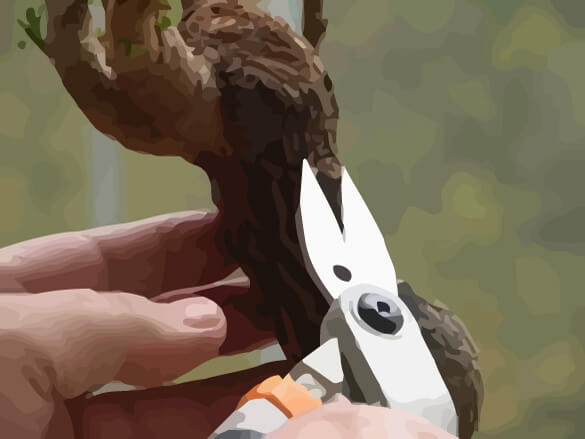Bonsai Tree Pruning: The Right Approach for the Right Tree
Table of Contents
With correct positioning, watering, feeding, and repotting, your bonsai should grow vigorously. Then the skills of shaping and grooming the tree come into play, partly to maintain the design you have created, and also to improve and refine it.

One technique of maintenance pruning is called pinching back or finger pruning. This encourages secondary growth further back on the branch or twig, producing bushy foliage that makes the tree look more mature.
Without pinching back, the most vigorous shoots, usually on the topmost branches, grow strong and thick, resulting in a top-heavy look as the lower branches wither and die. Trim top shoots early on to prevent this, but allow the lower branches to spread out and thicken before trimming. This method produces delicate twigs at the apex and strong lower branches. It will also thicken trunks on developing bonsai. You must, of course, accompany pruning with correct watering and feeding.
Finger Pruning a Conifer
Conifers such as cedars, cryptomerias, larches, spruces, and this juniper, are usually finger pruned; trimming with scissors turns the cut shoots brown and temporarily spoils the bonsai. You will not cause any damage if you use the soft pads of your fingertips. The two types of conifer foliage – scale-like and needlelike – require different methods of finger pruning. The trees mentioned above and some junipers have needles, cypresses and other junipers have scale-like foliage. Some junipers have one type of foliage; others have needles when young, and scale-like leaves when mature. Such foliage is known respectively as “juvenile” and “adult”.
Finger Pruning Species With Scale-Like Leaves
- Leading shoots are removed with a twisting movement. Hold the branch with one hand. Using the thumb and forefinger of the other hand, grasp the leading shoot so that you twist the shoot as you pull it.
- The objective is to break the shoot cleanly and neatly from the branch without causing damage to the remaining foliage. Do this by using a twisting motion at the, same time as you firmly pull the shoot away from the tree.
- Continue finger pruning over the whole tree to refine the lines of the design and create a balanced shape. Pay particular attention to the apex of the bonsai to prevent it becoming ragged and untidy.
Finger Pruning Species With Needles
- Grasp the branch with the finger and thumb of one hand and gently but firmly take hold of the leading shoot between the pads of the thumb and forefinger of the other hand.
- In a single, sharp movement, pull the branch straight toward you. If you do this correctly, the shoot will break away neatly from the shoot leaving the rest of the foliage intact.
- Pinch out the shoots over the entire apex of the bonsai and do as much work as necessary to tidy up the branches. Finger pruning in this way creates a more compact refined shape which emphasizes the trunk line.
Scissor Trimming Bonsai
Careful scissor trimming throughout the growing season can refine a bonsai's shape and encourage bushier growth.
You can use scissors to cut stems, but never foliage, which will look untidy and turn brown at the edges. Fingernails are best for pinching out very soft, young stems, and also for pine “candles” (the extending buds of pine trees), if they have not hardened. You will, however, have to use scissors to cut off tougher stems and candles, or you will tear the tissues of the stem.
Trimming A Deciduous Tree With Scissors
- Hold the shoot at the top and cut the stem directly above a leaf. Never cut through foliage as this will turn brown.
- Remove all long shoots that mar the outline of the bonsai. These cut shoots can often be used as propagating material.
Trimming Pine Candles With Scissors
- Position scissors with fine, sharp points carefully at the base of a candle so that you do not cut the surrounding needles.
- Make a single, neat cut through candles the base of the candle, ensuring you leave no ragged ends.
- Cutting away the candles refines the shape of the tree and that encourages new buds to develop.
Leaf Cutting
Some species such as birches, elms, and this Japanese maple produce leaves in continuous or successive flushes. If you remove all the leaves in summer, a second crop will sprout: this gives you two year's growth in one, because the new leaves emerge from next year's buds. They are usually smaller, and their autumn color brighter, than those of the first flush of leaves. The leaf-cut Japanese maple produces a second crop of its bright red spring foliage. Timing of leaf cutting is vital. If you do it too soon, the new buds will not have formed; too late, and the new leaves may not harden off before the fall, leaving insufficient time for replacement buds to form.
Leaf Cutting Technique
- Using scissors, remove leaves carefully and systematically, starting at the top of the tree and working your way downward to the lowest branches.
- Cut off each leaf directly behind its base, leaving the petiole (leaf stalk) sticking out from the trimmed branch.
- Allowing petioles to stay in place conserves moisture for the dormant buds at their bases. The petioles will drop off before the new buds open.




Leave a Reply